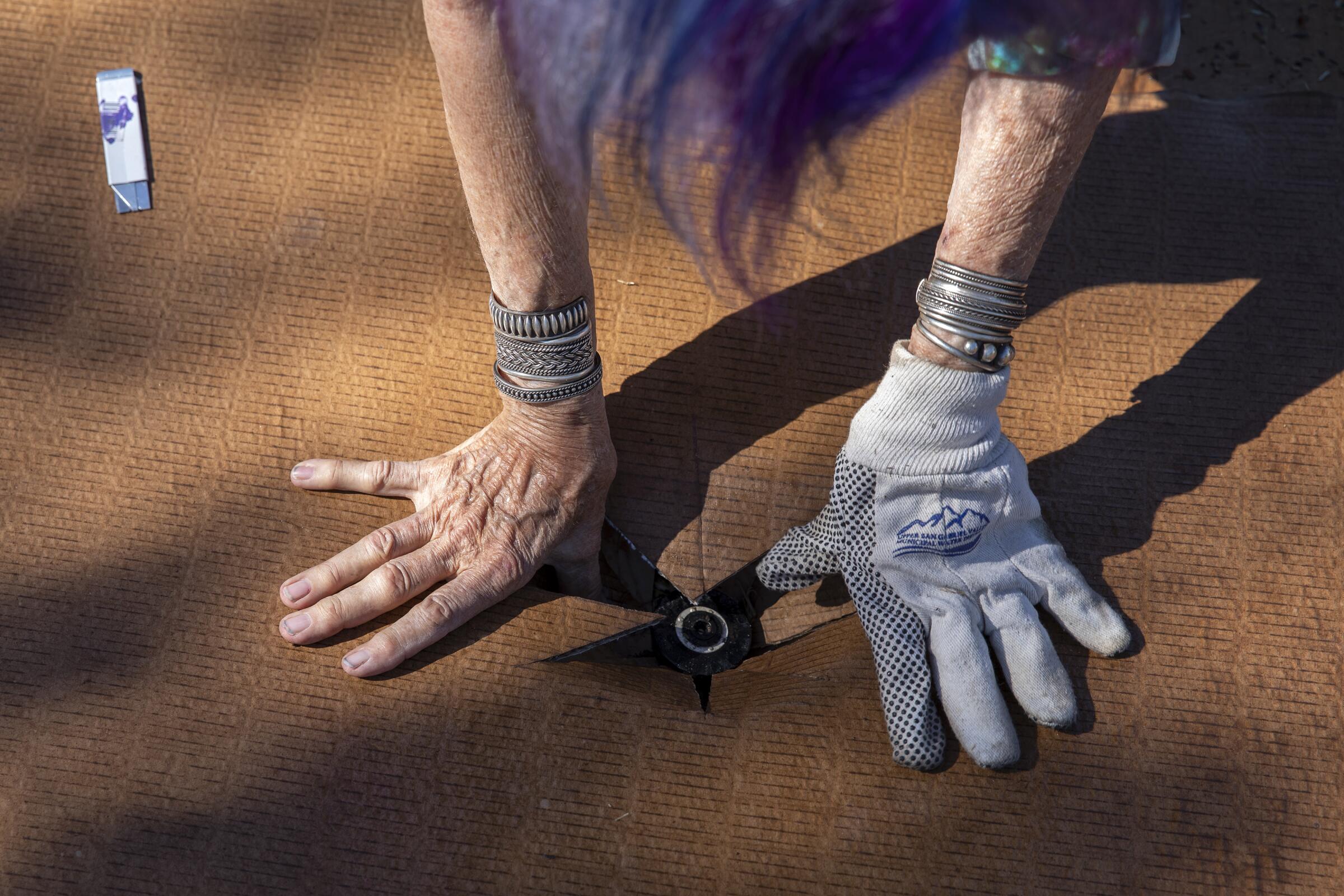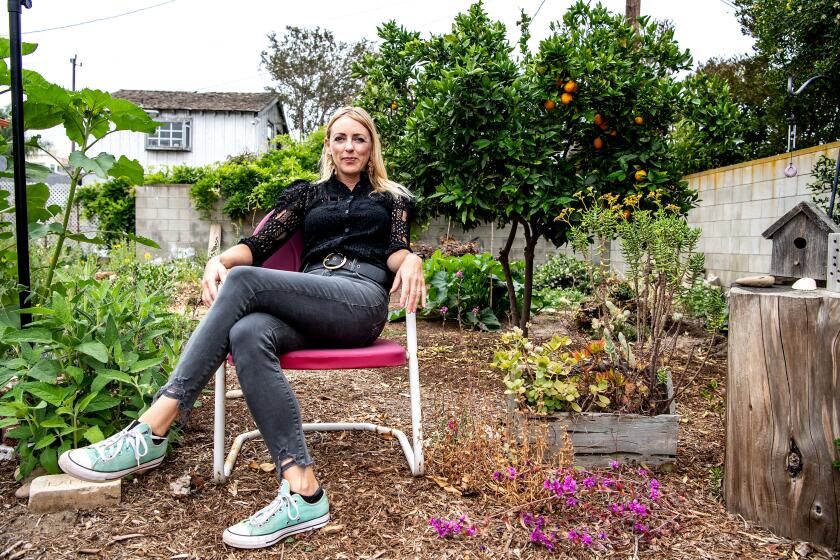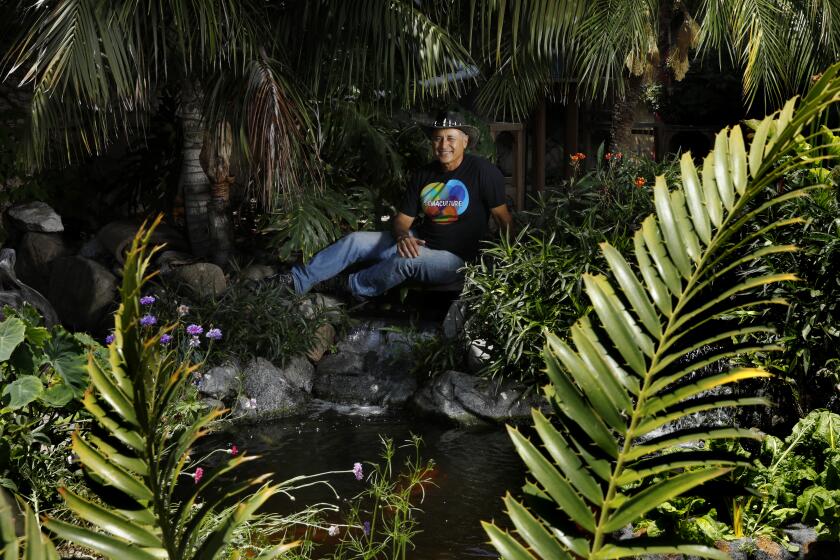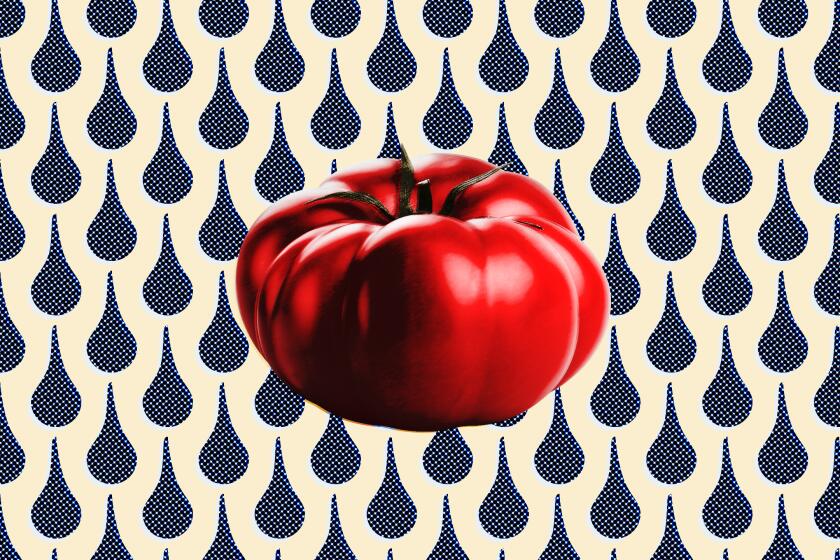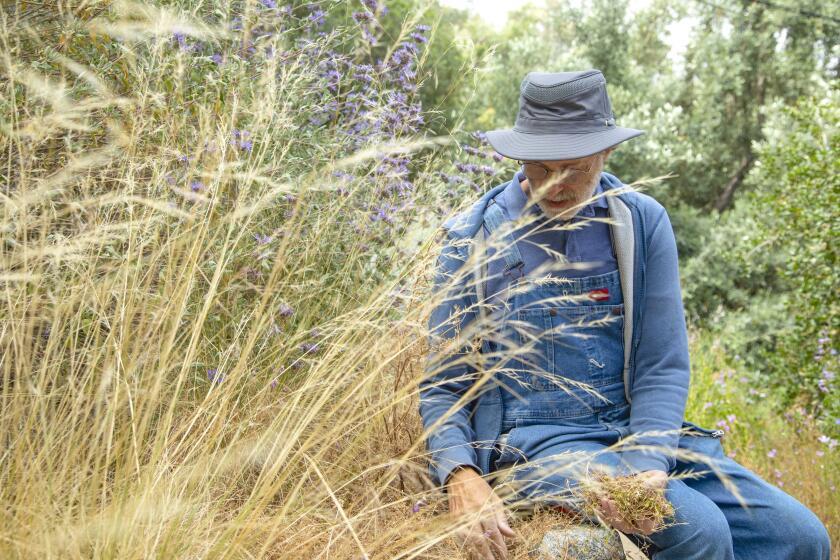Jeanette Marantos is a Features reporter focused primarily on plants, gardening and Southern California’s changing landscapes for the Los Angeles Times. She also writes the monthly L.A. Times Plants newsletter, which includes a calendar of upcoming plant-related events. Email calendar submissions or plant-related story ideas to jeanette.marantos@latimes.com for consideration.
- Share via
1
You can almost hear it: the crunch of crisping lawns all over L.A., thanks to the ongoing drought and recent restrictions on outdoor watering.
It’s no surprise, then, that many Angelenos are thinking seriously about ripping out their lawns in exchange for less thirsty landscapes and a $2-a-square-foot rebate from the Metropolitan Water District ($3 a square foot in Orange County).
Hiring a landscape contractor can make the project much easier but far more expensive, even with MWD’s rebate (and potentially more in some jurisdictions), so some people, especially those with smaller yards, are considering the DIY approach.
The MWD has made the rebate process easier. In the past, rebates were only available for removing living lawns, but when strict outdoor watering restrictions went into effect June 1, the rebates became available for removing dead or dying lawns too — just as long as there’s some kind of lawn in place and the project has been approved before the work begins. And the deadline for completing a project has increased from 90 days to at least 180.
But what’s the best way to proceed?
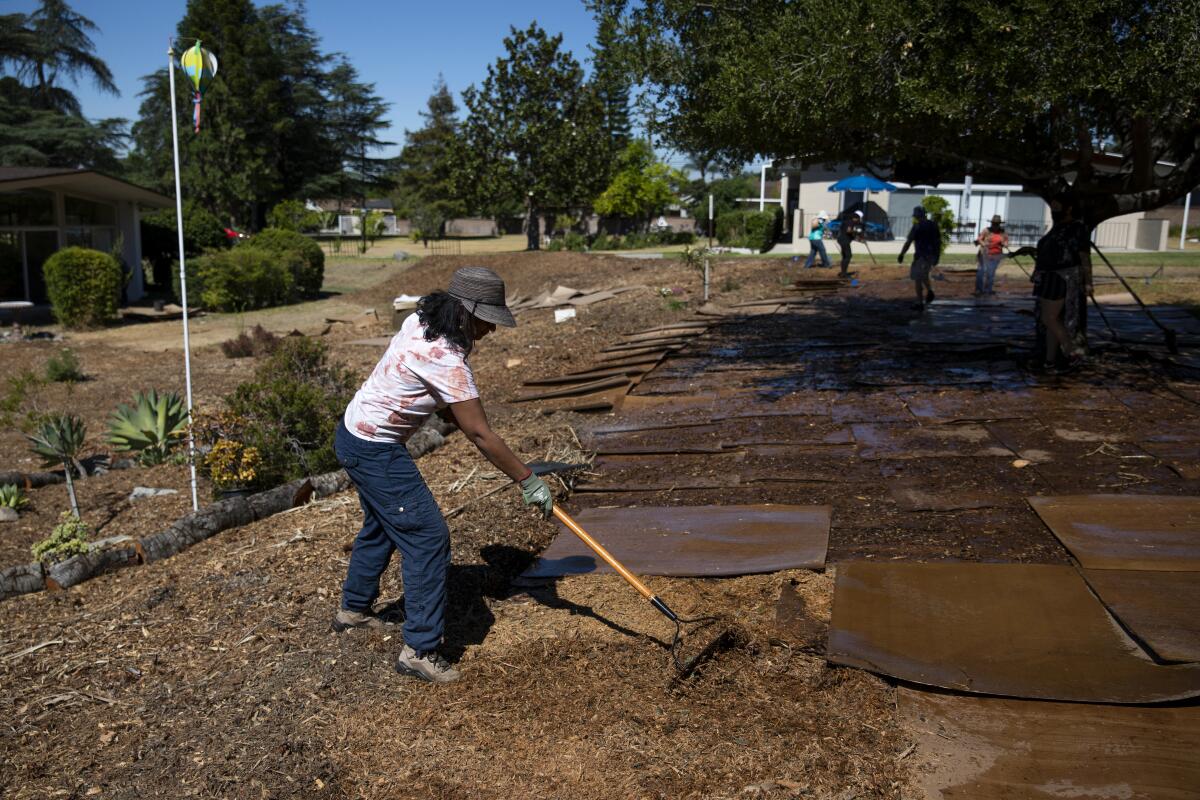
Volunteer Ansu John spreads mulch across wet cardboard as part of a sheet mulching project at Maryknoll Sisters retirement facility in Monrovia.
(Alisha Jucevic / For The Times)
There are several techniques, but the most favored is known as sheet mulching, a.k.a. lasagna mulching, which basically smothers your lawn under a ton of wet cardboard and mulch, creating a rich healthy soil teeming with beneficial microbes busy devouring the decomposing grass and cellulose in the cardboard.
That’s the goal anyway. The reality is no matter what you do, you’ll likely see stubborn grasses like Bermuda throwing up shoots and trying to reestablish. Which means the savvy gardener will have to be ever alert to spot those sprouts and pull them up.
But the other options have issues too.
- Herbicides may sound like the simplest approach, but they present health risks, especially in yards where children, pets and other creatures romp and rest. The landscapers we consulted have different techniques for lawn removal, but they were united against using chemicals such as glyphosate — the active ingredient in many weed-killing herbicides — because of studies linking exposure to a greater risk of getting Non-Hodgkin’s lymphoma, one of the most common cancers.
- Solarization sounds relatively easy — just cover your grass in plastic for a couple of months and let the intense heat carbonize your lawn. This process works as long as your lawn gets at least six to eight hours of direct sun every day, but it’s kind of a nuclear approach because it kills everything, including worms and other beneficial organisms vital to a healthy soil, creating a sterile dirt that will require amendments such as compost to keep plants alive.
- Sod cutting is basically digging out the lawn with a shovel or pick or special machine that cuts the sod into 12-inch strips a few inches deep. The problem with this technique is you end up with a lot of very heavy sod. Some people cut the sod, turn it over and then cover it with sheet mulching to try to ensure the grass dies. Most haul it away in a dumpster or a truck and pay several hundred dollars for its disposal.
Longtime landscape contractor Kirk Aoyagi favors the sod cutting approach because it’s quicker than waiting three to eight months for the sod to break down under sheet mulch, but he warns that this method is labor intensive.
First, the lawn needs to be wet — even if it’s dead — so the sod cutter can dig into the soil, but even then it only removes a few inches of turf. Sod cutters won’t dig up the deep roots of Bermuda grass, he said, so after he’s removed the top layer of sod, he rototills the entire yard and then combs through the soil with a fine-tooth rake to remove as many rhizomes and roots as he can before he starts replanting.
He never gets them all though.
Cool-season grasses like fescue and blue grass that stay green in winter have shallow roots that are relatively easy to remove, he said. Warm-season grasses that go brown and dormant during cool weather, such as Bermuda and St. Augustine, have much deeper roots that make them nearly impossible to eradicate.
Sarah Lariviere tore out her lawn and paid for a low-water replacement with a turf removal rebate. Here’s how she made it happen.
Most lawns, except those recently planted, are likely a mix of both, said Aoyagi, co-owner of FormLA Landscaping, a company that specializes in removing lawns and creating gardens and meadows from native plants.
“If your lawn is from the ’60s, or it’s been there for a very long time, I would expect that lawn to have pretty much every type of grass in the neighborhood,” Aoyagi said, “because typically the mowers from your maintenance team will bring in seeds and different types of grass from all your neighbors.”
That likely means you have Bermuda grass creeping through your yard, with its long, tenacious below-ground rhizomes and above-ground stolons poised to resprout no matter how thoroughly you comb through the soil, Aoyagi said.
“We’ve pulled up concrete and found Bermuda grass growing in mats, in places where it hasn’t seen the sun for years,” he said.
“It’s a pernicious weed, the king of weeds, so you just have to stay on top of pulling it out,” said Tim Becker, chief horticulturist for the Theodore Payne Foundation, which advocates for native plants. “Gardeners have lived and died by the will of Bermuda grass for centuries, nay, millennia, so it’s a worthy opponent. You’re fighting one of the best-adapted weeds of all time.”
Sophie Pennes and Leigh Adams, who specialize in native plant landscaping at Urban Farms LA and Studio Petrichor, respectively, are strong proponents of sheet mulching, but when it comes to tackling spots of Bermuda or crabgrass, they both recommend hand-to-hand combat.
Pennes’ technique, for instance, is to stop watering the lawn for 30 to 60 days, until it dies. She then waters the space and waits to see what sprouts. Typically it’s going to be Bermuda or crabgrass, she said, and at that point, “you just have to manually dig them out” before you start sheet mulching.
Bottom line: Removing your own lawn is doable, but it’s a big commitment of labor and time.
“This is a lot of work,” said Becker. “I love DIY, but I want people to have a realistic expectation. You need to be as efficient as possible.”
The size of the project can help with your decision, said Aoyagi. A 1,000-square-foot lawn is much easier to remove than one that’s 2,000 or 3,000 square feet.
“Know what you are getting into,” Aoyagi said. “Ask yourself: ‘Is this a job I can see myself finishing?’ If you have reservations … think on it a bit. Or hire someone to do the removal and cleaning, and then you take on the next phase.”
If you’ve been using gardeners to care for your yard, Becker recommended soliciting their help to remove the lawn and even help maintaining your new drought-tolerant landscape going forward. The Theodore Payne Foundation offers a free, nine-class course in Spanish and English for professional landscapers and gardeners — the California Native Plant Landscaper Certificate Program — to learn more about designing and maintaining native plant gardens.
“Don’t let this intimidate you,” Becker said. “Get help from your gardener. It’s a huge economic opportunity for them.”
So with that in mind, here are some general tips for removing your lawn and a guide to sheet mulching, the most popular method.
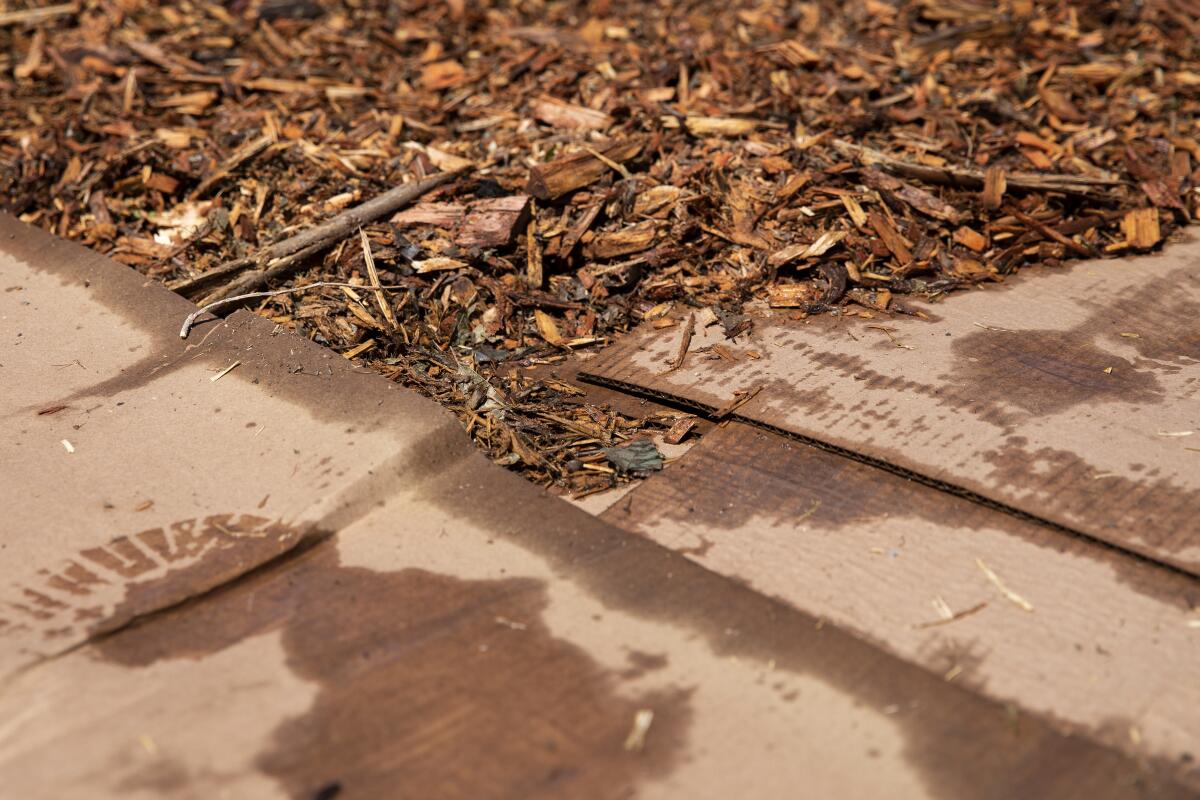
Wet layered cardboard and mulch, two critical components of sheet mulching.
(Alisha Jucevic / For The Times)
2
If you want a rebate, don’t do anything until you submit a plan
This is going to be a big project — even if your yard is small — so it’s vital you have a plan, if only to preserve your sanity. And if you want a rebate, the Metropolitan Water District is very clear that your project must be approved before you begin tearing out your lawn.
This is the time to consider what you want to plant in your yard after you remove the turf, said Aoyagi. And those decisions will guide what you choose for irrigation going forward and how you amend the soil.
A garden of native plants, for instance, requires very little water once the plants are established and no added amendments, said Evan Meyer, executive director of the Theodore Payne Foundation.
Finding your favorite nursery can be thrilling. Here are our picks for the best independently owned plant nurseries near Los Angeles.
“We get this question a lot — people think they have to bring in new soil after they remove their lawn, but when you’re planting native plants, your soil is totally good and fine. It’s not like growing vegetables that need a soil full of rich humus; native plants typically grow out of very lean soils. Our soils at Theodore Payne are basically decomposed granite, like sand.”
Having a plan will help you decide your sheet mulching method too. For instance, some people add a layer of compost over their cardboard and then top it with a wood chip mulch to build a richer soil, but if your focus is on native plants, you don’t need that layer of compost, said Adams. A 4-inch layer of wood chips over the cardboard is sufficient.
The good news is that summer is a great time to create your plan, assemble your materials and sheet mulch your lawn, since California native plants do best when planted in the late fall. But Adams said if you don’t want to wait that long, she’s successfully planted natives in the mulch before the cardboard has completely decomposed.
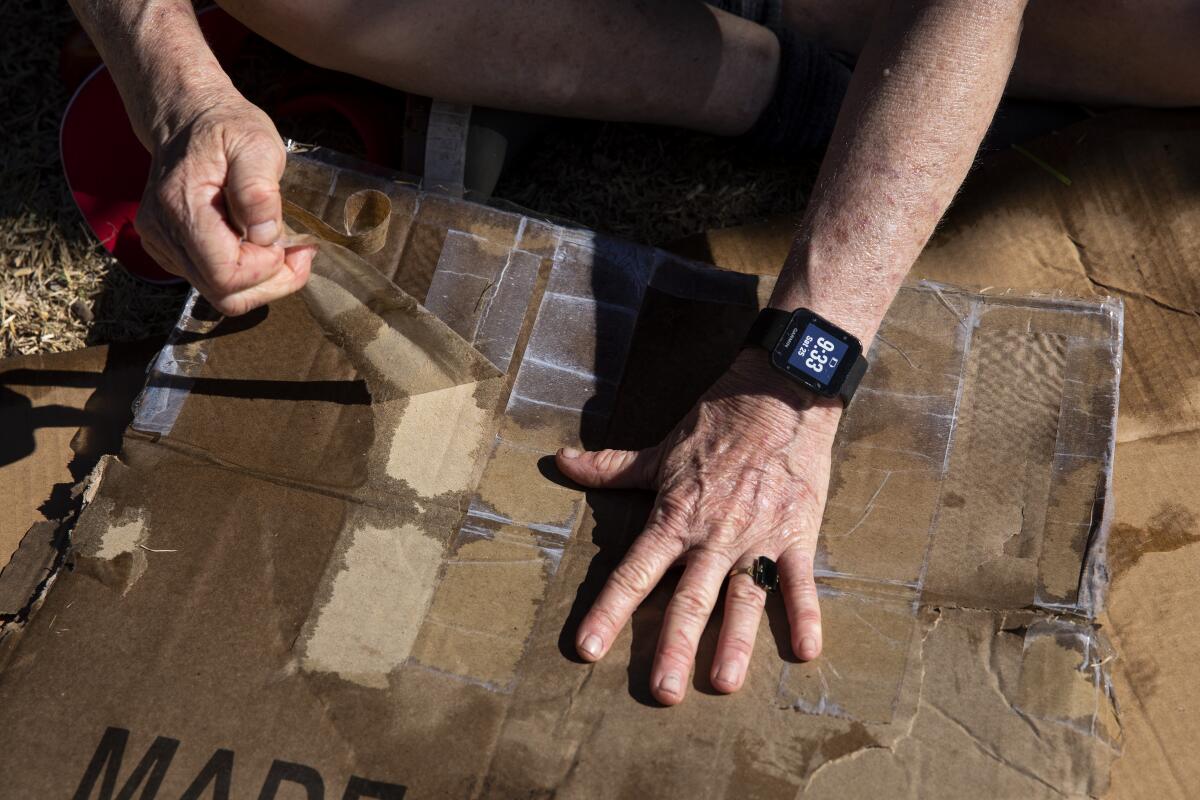
Elana O’Brien rips tape off a flattened cardboard box that will be used for sheet mulching.
(Alisha Jucevic / For The Times)
3
If you’re sheet mulching, start collecting and prepping your cardboard now
You can buy sheets of corrugated cardboard, but Adams said the beneficial organisms in the soil such as mycorrhizal fungi really love the thicker corrugated cardboard and glue in plain old shipping boxes. She puts out the word to friends and family and then scours cardboard recyclers, dumpsters and businesses — bicycle boxes are her favorite — to get the permeable weed barrier she needs ... and she always needs more.
“The No. 1 thing I tell everybody is, ‘You do not have enough cardboard,’” she said. “I cannot tell you how many workshops I’ve done where people swore they had more cardboard than was humanly possible to use, but they still had to leave halfway through the session to get more cardboard.”
Adams recommended taking the plain boxes apart so they lie flat and removing any plastic tape and metal staples. Don’t use cardboard with a shiny or waxed surface. Your pile will get big, but don’t be alarmed. It’s vital that the edges of the cardboard overlap by about 6 inches, to keep grasses from growing through the cracks, so you really will use all the cardboard you collect.
Another thing to consider: If you have a lot of Bermuda grass or crabgrass, Adams recommended using two or three layers of cardboard to suffocate the weeds as much as possible. Pennes said she also uses paper bags, newspapers and big rolls of rosin paper, used in construction as drop cloths, if she can’t get enough cardboard.
An important note here: Your weed barrier should be permeable, meaning it will decompose into the soil and let water soak through. Do not use commercial weed barrier. Those barriers inhibit water, making it harder for trees and shrubs to survive, said Adams. They encourage ant infestations because they keeps their nests relatively dry, she said, and stop the mulch from breaking down and improving the soil.
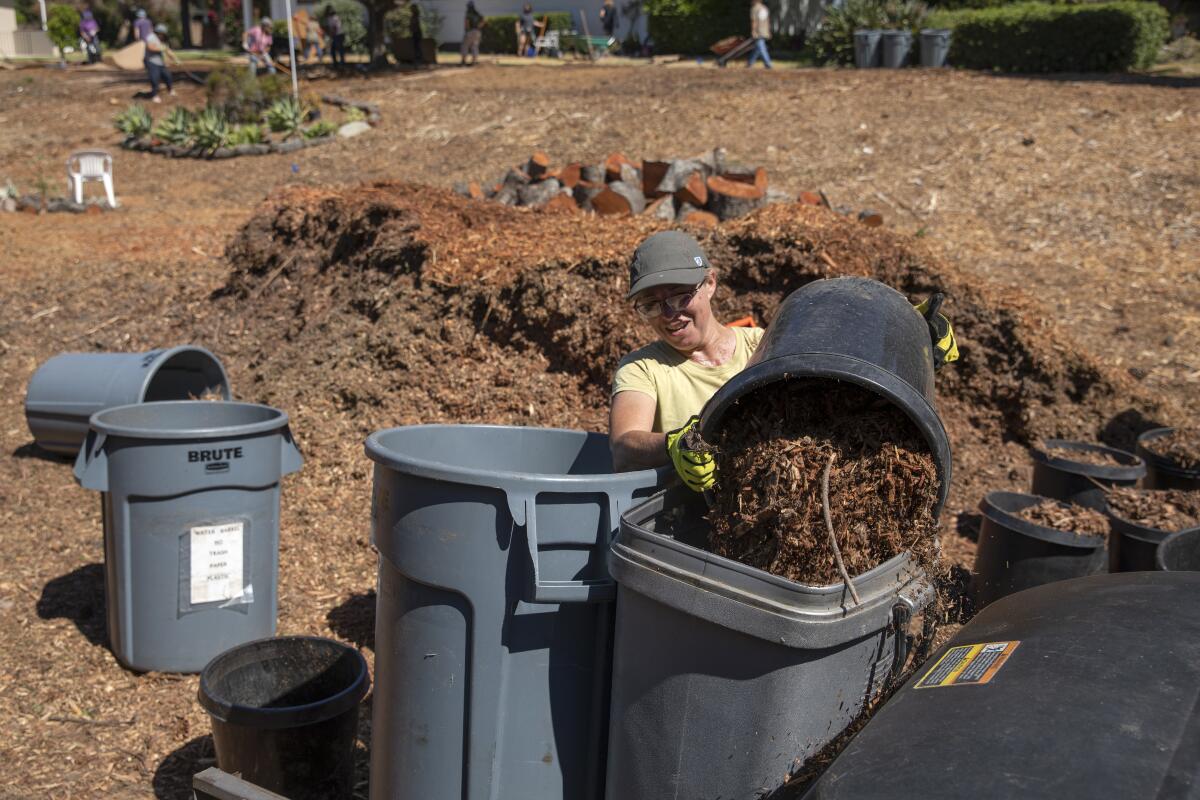
Volunteer Michele Brooke fills bins with wood chip mulch for spreading over wet cardboard.
(Alisha Jucevic / For The Times)
4
Decide where you’ll store a whole lot of wood chip mulch
A thick layer of mulch also helps smother the lawn and keep the cardboard from drying out and blowing away. Most landscapers prefer wood chip mulch because it breaks down more quickly than bark, helps retain moisture and encourages beneficial microbes, contributing to the lawn decomposition process and overall health of the soil.
You can purchase bulk wood chips from several nurseries and businesses such as Cal Blend Soils Inc. in Irwindale and Whittier Fertilizer in Pico Rivera, but it’s also possible to get wood chips for free.
Tree trimmers create a lot of wood chips, which cost money to dispose of, so they are usually eager to give those chips away. You can try talking to arborists directly and request a delivery of chips.
Replacing lawns with drought-tolerant plants is a good start in dry Southern California. Setting up a recycled water system is even better.
You can also sign up for free chip delivery through ChipDrop if you’re willing to live with a little uncertainty. Through ChipDrop, homeowners specify what kind of chips they don’t want, such as palm or loads with logs. But the deliveries can happen at any time without notice, from the day the request is made to many weeks later. Also, the amount can vary from 4 cubic yards to a full dump-truck load of around 20 cubic yards, which can bury a driveway.
Ideally, you’ll get a big load, which will allow you to spread a thick layer of mulch over your cardboard and even offer some to neighbors, but be sure you have a spot for the truck to dump the chips. Pro tip: You can usually get faster delivery if you offer to pay the $20 fee that ChipDrop charges arborists.
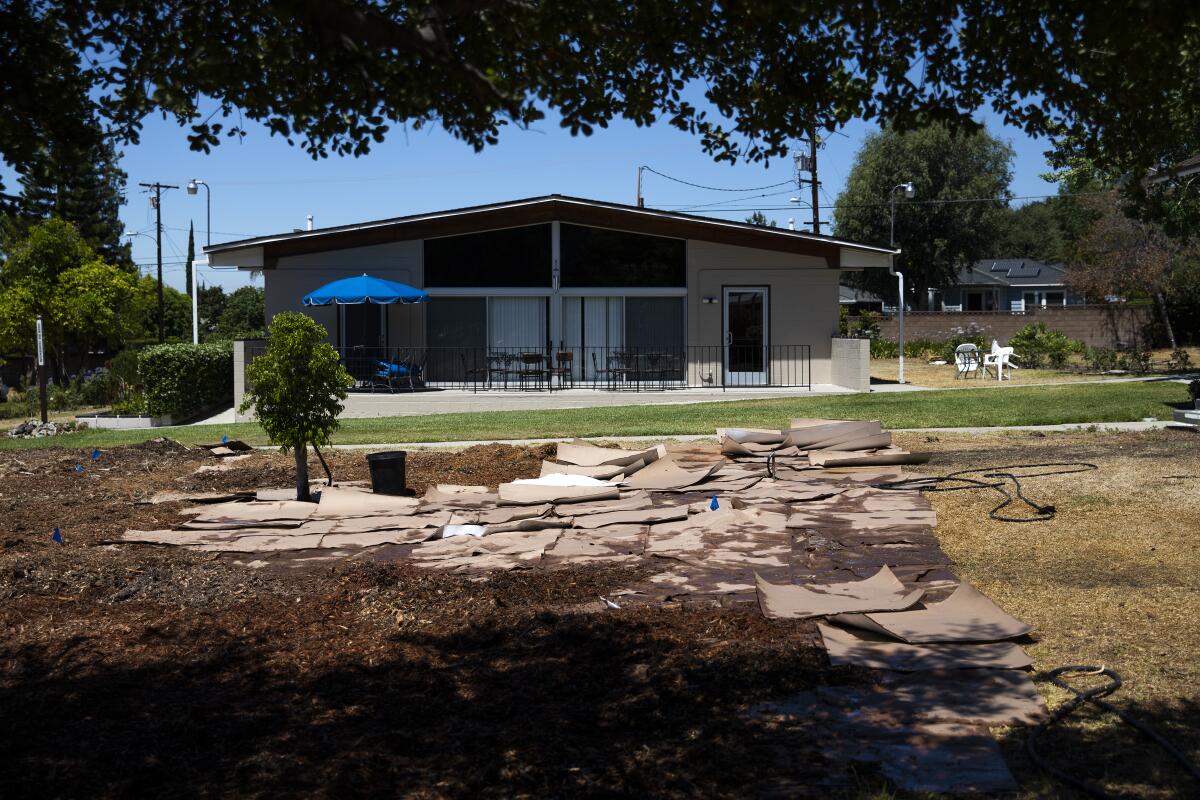
The sheet mulching process from start (far right) to finish (far left): dying lawn, wet cardboard and mulch.
(Alisha Jucevic / For The Times)
5
Flag your sprinklers and prep your lawn
While you’re waiting for mulch and your rebate application to be approved, make sure you walk the yard and mark the locations of all your sprinklers so you can install cardboard around them and more easily cap them off. Overhead sprinkler systems don’t qualify for rebates, so you’ll need to install some kind of drip irrigation or micro-spray system unless you intend to convert to hand-watering only. Consider whether that will be easier to install before you lay out your cardboard and mulch.
Adams saves smaller pieces of cardboard to put around sprinklers, cutting slits in a circle like spokes in a wheel so the cardboard can slip easily over the sprinkler head but still fit snugly against the pipe, blocking out sun to the grass below.
As Southern California’s drought conditions worsen, Los Angeles gardeners can keep their vegetables growing amid water restrictions with these tips.
This is a good time to prep the lawn too. Mow it low to the ground, leaving the grass clippings to add additional nitrogen to the soil, and remove any bulky weeds.
Becker suggested letting the grass die and then raking until you’ve collected as many long stolons of Bermuda grass as you can from the surface before you start sheet mulching. Even if the lawn appears dead, the stolons are the plant parts most likely to resprout.
Adams leaves large gaps around trees when she sheet mulches because damp cardboard and mulch against the tree trunks can promote disease. But that means the open ground is the perfect place for grasses to sprout, so she carefully digs out the grasses and weeds around trees.
It’s also helpful to dig out a 6-to-8-inch strip of lawn alongside walkways, to ensure the grass is well covered by cardboard and mulch.
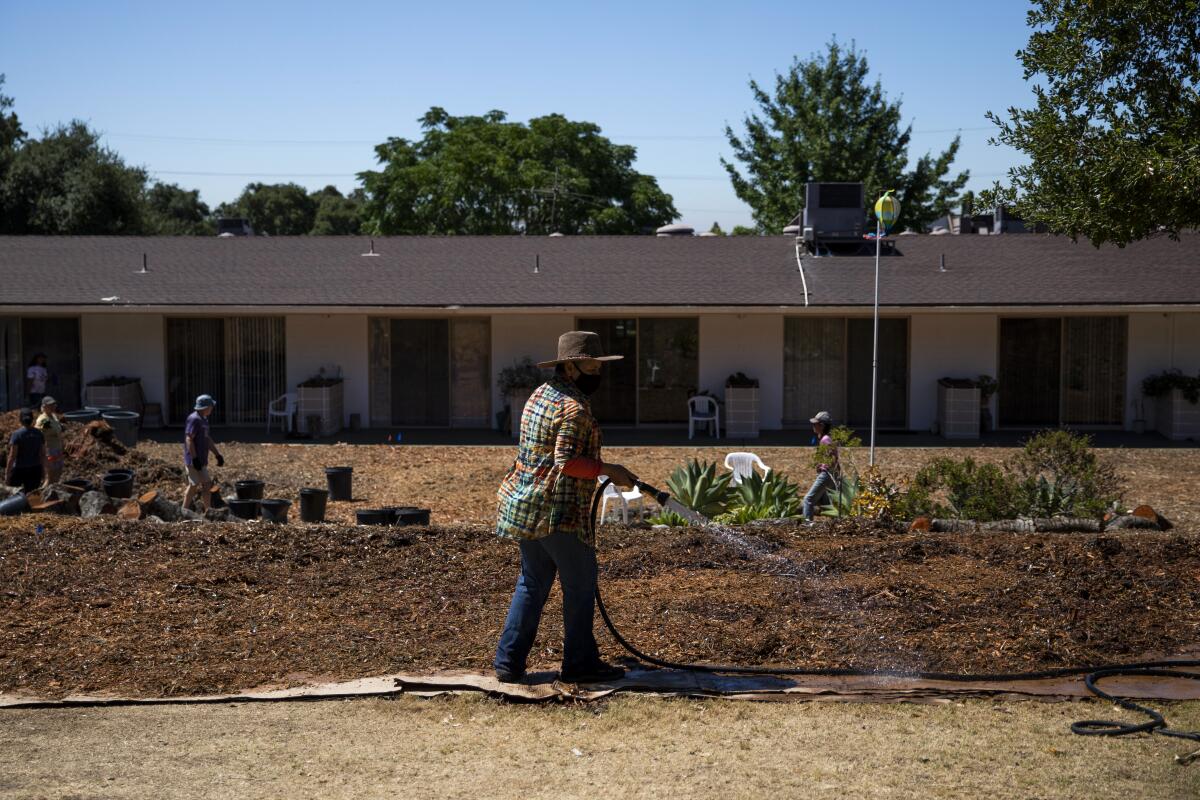
Volunteer Luz Oller hoses down a newly laid section of mulch at the Maryknoll Sisters retirement home in Monrovia.
(Alisha Jucevic / For The Times)
6
Gather some helpers and let the mulching begin
Once your materials are assembled and your rebate is approved, you’re ready to start mulching. The process is simple but time-consuming: You basically wet the cardboard, lay it directly on the lawn — overlapping the edges by about 6 inches — and then cover the cardboard with mulch.
It’s possible to do it alone, but Adams said it’s quicker and easier to have at least three people working at the same time — one to run the hose, one to lay the cardboard and a third to cover the cardboard with mulch.
Native plant gardens can look dead over the summer, but there are things you can do to tend to the dried-out vegetation.
Soaking the cardboard and the mulch, once it’s spread, is crucial because it activates the microorganisms that start the decomposition process.
“I tell my clients, ‘This is the last water you’ll ever waste on your lawn,’” Pennes said. “The water’s important because it brings the microorganisms and worms up from underneath the soil. They start eating the cardboard, they aerate the soil as they move through it and they poop ... it’s essentially just bringing the area back to life.”
7
Lawn removal resources and guides
- California Department of Water Resources: “Removing Your Lawn”
- California Native Plant Society: “Grass Removal Options”
- UCCE Master Gardeners of Sacramento County: “Beyond Lawn”
- Metropolitan Water District: “A Guide to Identifying & Removing Lawn Types”
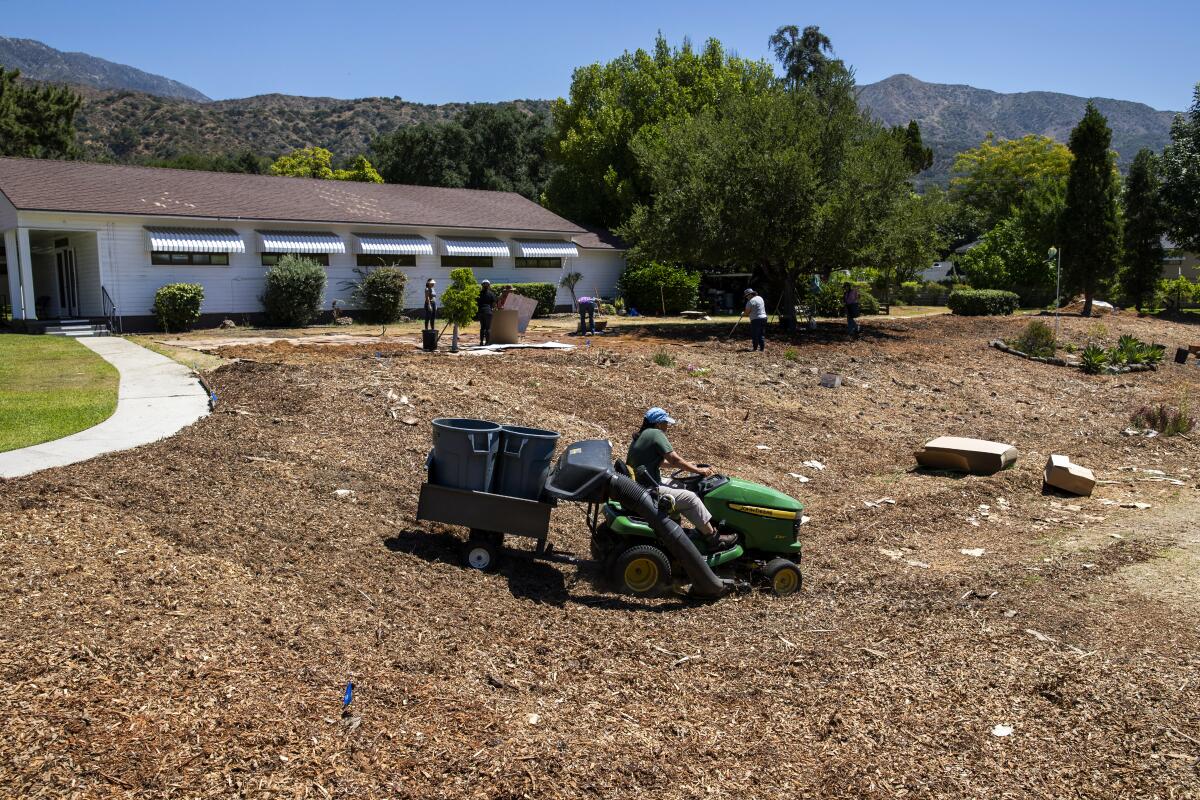
Volunteers work during a sheet mulching workshop hosted by Leigh Adams, a landscape designer for Studio Petrichor, at the Maryknoll Sisters retirement home.
(Alisha Jucevic / For The Times)
